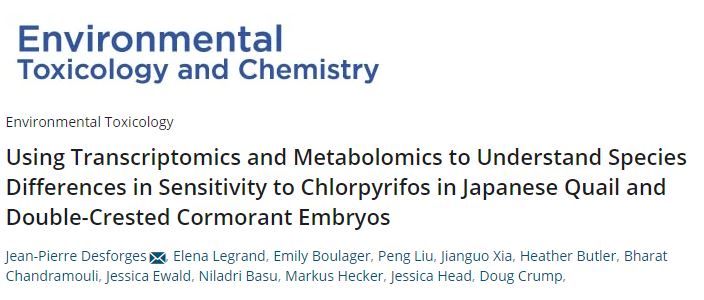Using Transcriptomics and Metabolomics to Understand Species Differences in Sensitivity to Chlorpyrifos in Japanese Quail and Double-Crested Cormorant EmbryosModern 21st-century toxicity testing makes use of omics technologies to address critical questions in toxicology and chemical management. Of interest are questions relating to chemical mechanisms of toxicity, differences in species sensitivity, and translation of molecular effects to observable apical endpoints. Our study addressed these questions by comparing apical outcomes and multiple omics responses in early–life stage exposure studies with Japanese quail (Coturnix japonica) and double-crested cormorant (Phalacrocorax auritus), representing a model and ecological species, respectively. Specifically, we investigated the dose-dependent response of apical outcomes as well as transcriptomics and metabolomics in the liver of each species exposed to chlorpyrifos, a widely used organophosphate pesticide. Our results revealed a clear pattern of dose-dependent disruption of gene expression and metabolic profiles in Japanese quail but not double-crested cormorant at similar chlorpyrifos exposure concentrations. The difference in sensitivity between species was likely due to higher metabolic transformation of chlorpyrifos in Japanese quail compared to double-crested cormorant. The most impacted biological pathways after chlorpyrifos exposure in Japanese quail included hepatic metabolism, oxidative stress, endocrine disruption (steroid and nonsteroid hormones), and metabolic disease (lipid and fatty acid metabolism). Importantly, we show consistent responses across biological scales, suggesting that significant disruption at the level of gene expression and metabolite profiles leads to observable apical responses at the organism level. Our study demonstrates the utility of evaluating effects at multiple biological levels of organization to understand how modern toxicity testing relates to outcomes of regulatory relevance, while also highlighting important, yet poorly understood, species differences in sensitivity to chemical exposure.
doi.org/10.1002/etc.5174 |
Jean-Pierre Desforges,Elena Legrand,Emily Boulager,Peng Liu,Jianguo Xia,Heather Butler,Bharat Chandramouli,Jessica Ewald,Niladri Basu,Markus Hecker,Jessica Head,Doug Crump, 2021. Using Transcriptomics and Metabolomics to Understand Species Differences in Sensitivity to Chlorpyrifos in Japanese Quail and Double-Crested Cormorant Embryos. Environ Toxicol Chem 2021;00:1–15. https://setac.onlinelibrary.wiley.com/doi/10.1002/etc.5174

